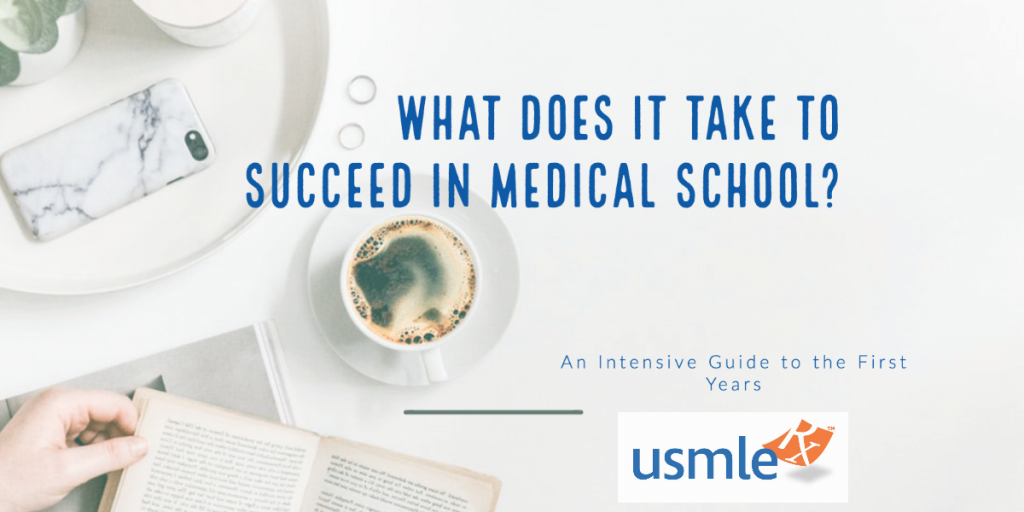Every student, teacher, and mentor you ask will have different advice about how to do well in med school. Review these flash cards, or watch these videos, or buy this list of Step prep resources. The simple truth is that there is no single answer to “What does it take to succeed in medical school?” Your best study practices will be your own, and finding them is a personal process.
To aid that process, start the first two years of medical school by building a solid foundation of knowledge. Many med students jump the gun and worry about what will be on the Step 1 exam when they would be better served by understanding what they need to know to start on the road toward becoming a physician. USMLE-Rx’s Rx Bricks digital learning system provides you with that knowledge as well as innovative ways to retain it. High-yield content is broken down into short, interactive lessons — or bricks — that clearly explain key topics and will help you learn how to study for Step 1.
The bricks are usually less than 20 minutes long and include interactive flash cards, practice questions, and mnemonics, along with easy-to-read content. Some of the more important features of Rx Bricks that will help you build a solid foundation and learn USMLE Step 1 content include:
- Narrative text modules that align with universal learning objectives.
- High-quality images, including interactive images with quiz mode.
- Clear and contextualized concepts, with time estimates for completing each brick.
- Prioritized, need-to-know content.
- Built-in review and self-assessment questions for deeper understanding.
- Measurable objectives at the beginning and conclusion of each brick.
By using the same platform to learn key concepts and review your understanding of them, you can always have quick access to your notes and important highlights. You’ll need them to figure out how to study for Step 1 — and med school in general — most effectively.

An Overview of USMLE Step 1 Content
The point of USMLE Step 1 is to assess your understanding and application of important concepts. There’s a greater emphasis on the sciences underlying the practice of medicine, including the principles and mechanisms behind diseases, therapies, organ systems, etc.
Starting in late 2020, there will also be an increased number of questions assessing your communication skills, systems-based practice and patient safety, legal and ethical skills, and overall professionalism. Before taking the Step 1 exam, you’ll have to master the sciences that will allow you to practice medicine safely and competently — which will be taught during the first two years of medical school. Studying for the Step 1 exam is a demanding, but beautiful art because it will prepare you to have such a rich understanding of a disease process, which will allow you to effectively communicate with your patients on the wards!
The Step 1 exam is computer-based and includes seven sections with 40 questions each. All questions are multiple choice, and the exam takes about eight hours to complete. You’ll have one hour for each section, a 15-minute tutorial preceding the exam, and a total of 45 minutes for breaks.
In the current USMLE Step 1 scoring system, a score of at least 194 is necessary to pass. However, in 2022, the scoring system will change to pass/fail for all USMLE tests except Step 2 Clinical Knowledge (CK). This change is meant to help lessen the stress on students preparing for the tests by reducing the emphasis on scored performance, although it’s completely normal to be stressed about the exam (no matter how it’s scored). That being said, it is still vitally important that you master the the medical content on Step 1, as this will provide you a framework for your learning for the rest of your career.
When you’re ready to register for Step 1, you can do so online by visiting the USMLE website. International students must register with the Educational Commission for Foreign Medical Graduates to receive an ECFMG identification number. Then, you’ll have to send a notarized Form 186 signed by a dean.
Now that we’ve covered how to register for USMLE Step 1, let’s get to the important stuff — how to study for USMLE Step 1.
How to Study for Step 1
Studying for Step 1 is no small task. You have a massive body of knowledge to attain, and (usually) no indication of what specific knowledge applies to the test. Therefore, the trick to studying for Step 1 is practical application via question banks. This approach exposes you to the style of questioning and reasoning you’ll need to get the right answers — it also shows you the common types of high-yield subject matter you’ll need to absorb. The importance of high-quality practice questions cannot be emphasized enough; the more practice questions you do, the more prepared you will be to answer any question Step 1 throws at you!
The second way to perfect your studying is to supplement those question banks with readings, videos, and other online material. These are especially important early in your USMLE Step 1 study schedule because they can give you the basic knowledge you need for board-style questions. You can then work in bite-sized chunks by splitting up the material by subject, organ system, discipline, etc. You want to get the most out of each practice question you do and before you can do that, you need to have a baseline knowledge of the subject before applying that knowledge to a clinical vignette.
Having all of your resources in one platform, such as USMLE-Rx, will prove invaluable in digesting chunks of information. For example, USMLE-Rx allows you to take tests in Tutor Mode, which removes all time constraints and allows you to get immediate feedback on each question (rather than having to finish the test before reviewing the answers). As you progress, you can move to Untimed Mode, which captures the feel of the test without the stress of a timer. When you’re ready, you can move to Timed Mode to assess your abilities with a timer running. And when you finally want to simulate exam day, you can take one of two self-assessment exams — or create a simulation that gives you an authentic taste of exam day.
That said, you might find a different study method and resources that work for you. Whatever process you land on, stick to it.
The Tools and Strategies You Need to Study for USMLE Step 1
Using a system like USMLE-Rx, with its Rx360+ study suite, helps you stick to a more efficient USMLE Step 1 study schedule. And without a set USMLE Step 1 study schedule and plan, you won’t likely be able to cover every subject before the exam. If you try to plow through a mountain of information without a study strategy, you’ll likely waste time on low-yield topics that might not even be on the test. By spending an optimal amount of time on each subject, you can increase your score significantly.
Minimizing the complexity of your schedule will allow you to spend more time focusing on content review and practice questions and less time trying to figure out what resource to use next. To design the study plan that works best for you — and stick with it until you’ve passed your Step 1 exam — consider these tools and strategies:
-
Start studying early.
It’s natural to wonder what it takes to succeed in medical school and pass the USMLE Step 1, but the best answer is getting an early start on studying. After all, embedding critical concepts into your long-term memory takes time. You want to give yourself adequate time to employ spaced repetition techniques, while also introducing new material. This will also ensure you have plenty of time to study concepts that might confuse you or take longer to grasp. The Rx Study Planner tool can help you weigh your understanding of each subject and plan your time accordingly. It also calculates the hours you need to spend on each subject, which eliminates any guesswork when creating your USMLE Step 1 study schedule.
-
Reinforce concepts with flash cards and videos.
Flash cards are a necessity for every medical student. They are a quick way to test yourself on the new knowledge you recently obtained and are an excellent way to revist old material that you want to store in your long term memory. With Flash Facts — a tool exclusively found in Rx360+ — you don’t have to make your own cards or guess which ones have the highest-yield USMLE Step 1 content on them. Flash Facts includes more than 14,000 flash cards to choose from, covering every major area you’ll need to study in preparation for Step 1.
You can also use the Study Stream tool to help commit information to your long-term memory. Study Stream works by presenting topics for review based on your confidence level. It uses spaced repetition to help you nail down concepts, improving your subject mastery and information retention. In addition, you can master the material faster with more than 1,300 interactive, expert-reviewed Express Videos — one for each subject in “First Aid for the USMLE Step 1.” These high-quality videos are only available on Rx360+, which includes the complete USMLE-Rx study suite.
-
Assess yourself with Qmax.
It’s one skill to be able to retain information when reading a textbook or watching an online video. However, it is an even more important skill to be able to learn how that content presents itself in a clinical vignette. When figuring out how to study for Step 1 during the first year of med school, some students may not immediately think of using a Qbank. It might seem too soon if you’re just starting, but don’t wait too long to take advantage of one of the best ways to learn the material. USMLE-Rx’s Qbank, Step 1 Qmax, gives you access to more than 2,300 USMLE-style questions. Using Qmax helps with retrieval and long-term retention of material. What’s more, there’s a positive correlation between the number of practice questions med students answer and their scores on Step 1.
-
Use SmartNotes to keep track of key insights.
SmartNotes is another helpful USMLE-Rx tool that allows you to take notes and highlight high-yield information across Rx Bricks, Qmax questions, Flash Facts, and First Aid for the USMLE Step 1. SmartNotes was designed to suit a broad range of note-taking styles and strategies, so it can be personalized to work best for you. Because it’s integrated throughout the USMLE-Rx ecosystem, you can easily reference the most relevant notes and highlighted information for any subject.
-
Take periodic self-assessments.
Meaningful self-assessments are the best way to gauge your progress throughout your USMLE Step 1 study schedule and plan. To reach your studying goals, consider taking a self-assessment at the beginning of your study process (this will give you a baseline of where you stand with the material) using USMLE-Rx’s self-assessment exams; you can also create a simulation in Qmax. Once you’ve taken that first exam, test yourself repeatedly over time. This repetition will show you which concepts and topics you’re absorbing — and which ones you still need to learn before taking the exam. This is why it is important to take periodic self assessments early on in your Step 1 studying journal, so you can tailor your studying to your own specific needs.
-
Prioritize personal wellness — not just studying.
Lastly, it’s important to get adequate sleep, eat well, exercise regularly, and generally take care of yourself during your test prep (and throughout med school). The best way to ensure daily wellness is to block off time each day to exercise, preferably in the middle of the day, to give yourself a much deserved break in your studying! During the first two years of medical school — and the third and fourth years of medical school — it’s all too easy to get overwhelmed and overly stressed. Mental and physical wellness will keep your body and mind in shape throughout your med school journey. Studying for USMLE Step 1 testing is especially grueling, and it’ll be even harder to retain the information you’re working to absorb if you don’t prioritize your personal wellness.
What You Need to Know About Retaining USMLE Step 1 Content
The key to remembering USMLE Step 1 content and succeeding in med school is to retain vast amounts of information using the above strategies. While there are a few topics you can cram, it’s not advised for most of the core subjects — especially since cramming doesn’t help you retain information in the long term.
Among the various effective ways to comprehend complex information, studies show that repetition over time is one of the most valuable methods. This can include:
- This involves studying multiple unrelated concepts at the same time. Using randomized questions in Qmax, for example, is an excellent way to use this strategy — and it simulates the exam’s pattern of questioning more accurately.
- Elaborative interrogation.Don’t just read and recite information; question it. Forcing yourself to think about the why of a fact will help you remember the material more effectively and recall it in several different contexts.
- Mnemonic devices.Mnemonic devices help you process and remember specific bits of information. These can include acronyms, images, and music.
- Trial and error.Experience really is the best teacher, such as failures to complete a practice test in time or to answer all the questions correctly. The more you test and self-assess, the more successfully you can retain what you learn.
The Next Step: Your Third and Fourth Years of Medical School
After you take the USMLE Step 1, you’ll be able to move on to the third and fourth years of medical school. Typically, med students start their clinical rotations in the third year of medical school. If you’re wondering how to succeed in the third year of medical school, having a solid foundation built by Rx Bricks and reinforced by First Aid will go a long way. After all, you’ll have to apply that information in a real-world setting.
In the third year of medical school, you’ll need to take the USMLE Step 2 CK exam. It’s generally more beneficial to take this exam before applying to residency programs because it will help showcase your clinical knowledge. Many residency programs, such as internal medicine and emergency medicine, hold Step 2 CK results in high regard, and a good score can give you a leg up on the competition.
The Step 2 CK exam assesses your application of medical knowledge, skills, and clinical science, with a specific focus on patient care. Unlike Step 1, there’s a greater emphasis on patient-centered skills and a demonstrated ability to practice medicine safely and competently. Questions will shift from pathophysiology and mechanism of action to more diagnosis and management of common and uncommon clinical syndromes in every day practice. Registering for the Step 2 exam is the same process as Step 1. For USMLE Step 2 tips on studying, simply review the same strategies and tools we provided for Step 1.
Once you complete the Step 2 exam, you can start applying for residencies late in your third year of medical school or early in your fourth. At this point, it’s time to tie everything you’ve learned over the past few years together. Here’s what you should keep in mind when applying for residencies:
- Write a killer personal statement.This might seem insignificant, but it’s one of the few aspects you can control in the application process. Your statement should be personal to help the program directors understand your personality, what drives you, what you want to achieve, and what you can bring to the program. Take time to check for and correct spelling and grammatical errors, and clean up any strange formatting choices that could make you stand out for the wrong reasons. Have friends, family, and professionals read it — and write several drafts until it’s perfect.
- Practice the interview over and over.After seeing you on paper, interested program directors will want to assess you in person (or using a videoconference service like Zoom). Practice speaking personally (not robotically or rehearsed) as often as you can before the interview.
- Analyze the program and directors for yourself.When you reach the interview stage, it’s assumed that both sides are interested. That means it’s your chance to determine whether your interest is warranted, too. You’ll be in the program for the next several years, so invest the time to make sure it offers exactly what you want.
What Does It Take to Succeed in Medical School and Your Exams?
Remember, medical school is a journey filled with plenty of ups and downs. And there’s no one right way to succeed — although a platform like USMLE-Rx can help!
The best piece of advice is to find the study methods and strategies that work best for you early in the process and then stick to them. At the very least, you’ll know you’ve done everything you can to excel and reach your goals.
USMLE-Rx is a tool designed by the team that created “First Aid for the USMLE.” Today, the platform is used by students in more than 200 countries, representing more than 1,000 medical schools. USMLE-Rx is aimed at helping medical students learn, understand, remember, and apply core medical knowledge. Through early study with the platform, students see an average increase of 4.2 points in Step 1 exam scores.
If you’re starting your med school journey and need help preparing, click here to start a free trial of USMLE-Rx.




